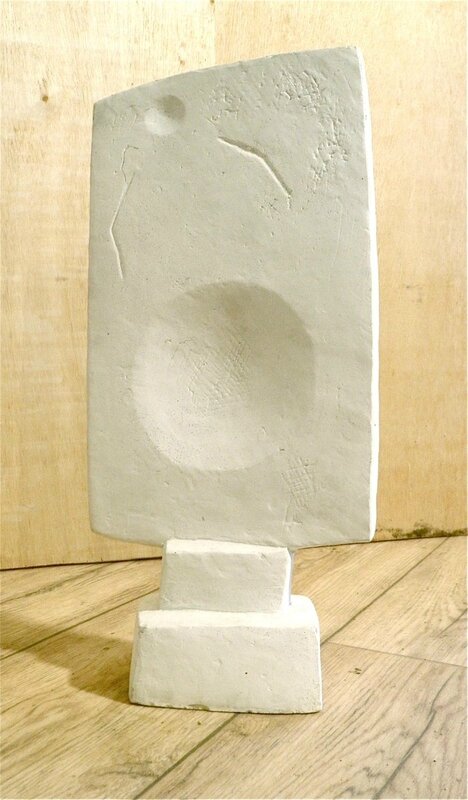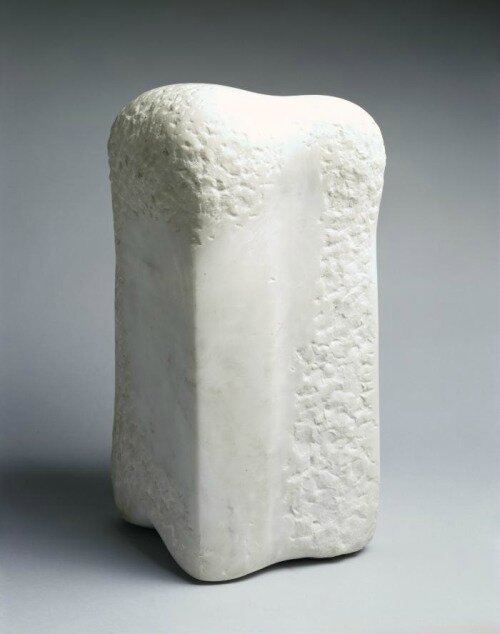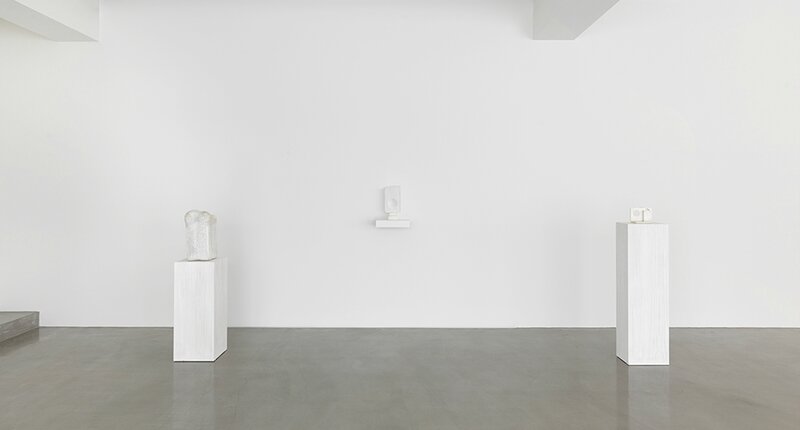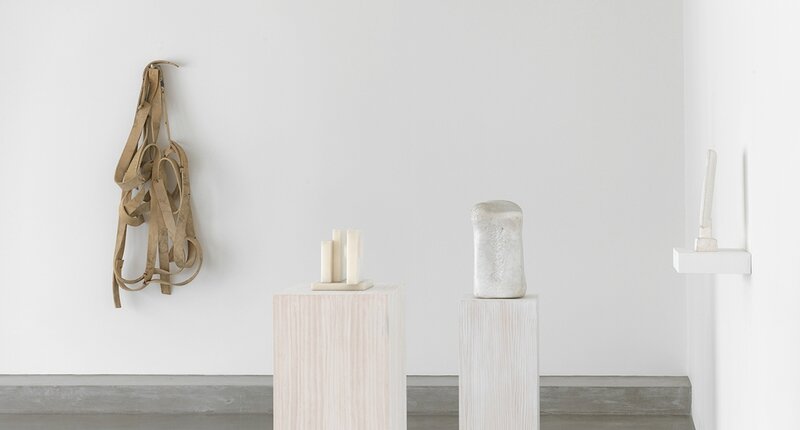Rare sculptures by Alberto Giacometti and Richard Serra on display for the first time
LONDON.- Monochrome, an exploration of the use of a single colour – white – focusing on sculptures by a number of significant 20th century artists, will open at Ordovas, London, from 10 February until 22 April 2017. Presenting works rendered in various tones of white by Eduardo Chillida, Alberto Giacometti, Barbara Hepworth, Isamu Noguchi and Richard Serra, the exhibition will explore the depth and diversity that is found in the use of white, a colour that is long associated with purity and clarity. The exhibition will include Alberto Giacometti’s Femme, considered to be a pivotal link between British and European modernism in the 1930s, which will go on public display for the first time since it was made almost 80 years ago.
Alberto Giacometti (1901-1966) made Femme in 1928-29. One of Giacometti’s most simplified female figures – flat and almost abstract – Femme is a negative relief that hovers between two and three dimensions, and evokes the sculptor’s fascination with African and Oceanic art. With its pure white form, pared down to the bare essentials, Femme is known to have been a key influence for a generation of British sculptors including Henry Moore, Barbara Hepworth and Ben Nicholson. Despite plaster works being an extremely important part of Giacometti’s oeuvre, many early plaster pieces have been lost, either due to lack of space in the studio he shared with his brother Diego, or because they were damaged during the casting process; the majority of his surviving plasters are now housed in the collection of the Fondation Alberto et Annette Giacometti. The plasters demonstrate very direct contact with the hand of the artist, and many celebrated bronzes originate from hand-shaped forms made of plaster. Bearing traces of interventions after the plaster had hardened, many of Giacometti’s plaster works show evidence of scrapings, scratches, indentations and even places where the plaster has been gouged out with a penknife. This further working makes each plaster unique, and a number of them were not used to make casts for bronzes but were presented as sculptures in their own right, including Femme.
Alberto Giacometti (1901-1966), Femme, 1928-29. Photograph: The Department for Culture, Media and Sport
Maquette for Large Sculpture: Three forms (Two circles), a serravezza marble sculpture made by Barbara Hepworth (1903-1975) in 1966, recalls the purity and seeming simplicity of works she made in the 1930s. It is one of a group of four sculptures that Hepworth made in 1966 in which the smooth porcelain surfaces of white marble became a medium for spatial abstraction.
Each sculpture is small in size and each is composed of circular holes carved from rectangular planks of marble compositions of overlapping forms. The 1960s was an exceptionally successful period for Hepworth, who by this time was widely acknowledged as the world’s greatest female sculptor. Yet despite the widespread success and public recognition during these later years, Hepworth faced a private struggle when she was diagnosed with cancer in 1965. The topic of death pervades Hepworth’s work in the ensuing years and was a strong factor in the monumental size of sculptures that she produced in her late career. Maquette for Large Sculpture: Three forms (Two circles) embodies all of the ideological elements and notions of form and scale imperative to Hepworth’s art. It is being publicly displayed in London for the first time since 1972.
Dame Barbara Hepworth (1903-1975), Maquette for large sculpture: Three forms (Two circles), signed with initials and dated 'B.H./66' (on top of the base); signed and dated 'Barbara Hepworth 1966' (underneath the base), serravezza marble, 13.5 x 20.5 x 11.5 cm. Executed in 1966, this piece is unique. © Christie's Images Ltd 2013
Executed one year later, in 1967, Rosa Esman’s Piece, a vulcanized rubber sculpture by Richard Serra (b. 1939) is also included in Monochrome. It is a rare piece that Serra made contemporaneously with his work on the ‘Belts’, executed in 1966-67. In the mid-1960s Serra began experimenting with nontraditional materials including fibreglass, neon, vulcanized rubber (a process of treating in a zinc chloride solution to make the rubber more durable), and, later, lead. He combined his examination of these materials and their properties with an interest in the physical process of making sculpture. The result was a list of action verbs—”to roll, to crease, to curve”—that Serra compiled, listed on paper, and then enacted with the materials he had collected in his studio. Serra was very interested in the materiality and the substance of rubber; his first studio in New York was next door to a warehouse containing many pieces of discarded rubber that he collected and experimented with. He was intrigued by the material’s weight and spatiality and the fact that it was malleable and able to be manipulated like heavy and dense clay. Other major rubber works include To Lift (collection of the artist) and Belts (Guggenheim, New York). Serra has described ‘Belts’ as a response to Jackson Pollock’s Mural (1943-44), and the work asks us to imagine the painted line in three dimensions. Each drooping strand of rubber is a drawing made over into a bodily, industrial shape, its once pristine surface smudged with layers of dirt and grease.
Richard Serra (American, born 1939), Rosa Esman's Piece, 1967. Sculpture, Vulcanized rubber, 26 x 15 in. (66 x 38.1 cm.) © Castelli Gallery
Becoming, executed by Isamu Noguchi (1904-1988) in 1966-67, is one of the last marble sculptures the artist ever made, marking the cusp of his transition to harder, less fragile sculpting materials. It was completed a year before his first retrospective in the United States, at the Whitney Museum of American Art, New York. Noguchi did not belong to any particular movement, but collaborated with artists working in a range of disciplines and schools. However, no one had a more significant impact on Noguchi’s oeuvre than Constantin Brancusi, for whom he worked as a studio assistant in Paris during the 1920s. Brancusi taught Noguchi how to use carving tools and honour his materials, and greatly inspired the younger artist with his elongated and reductive forms. Having worked with marble in his early career, Noguchi later shifted to harder stones, including granite, which offered more resistance to his overriding desire to continually work and reshape the stone. However, granite did not show the variation in surface texture that Noguchi sought; before moving to Japanese basalt stone, he returned briefly to work with white marble, a material that he understood and had great respect for. It was during this period that he carved Becoming.
Isamu Noguchi (1904-1988), Becoming, 1966-67, marble. Photo by Kevin Noble © The Noguchi Museum
Eduardo Chillida (1924-2002) executed Gurutz VIII in alabaster in 2000. A pioneer of modernist sculpture, who produced an extraordinary body of work over 50 years, Chillida is hailed as one of the most important 20th century sculptors. He made his first work in alabaster in 1962 following a trip to Greece. Here he was inspired by architecture and light, and saw alabaster as a material for constructing space – enabling him to show the flow between interior and exterior and the communication between light and the material. Gurutz, meaning ‘Cross’ in Basque, was one of approximately 50 alabaster works that Chillida created, and he continued working with this transformative material until his death in 2002. As with Chillida’s monumental corten steel sculptures, his intimate works rendered from blocks of alabaster reflect his unique process and distinct use of line and space.
Monochrome installation view, Photography by Mike Bruce
Monochrome installation view, Photography by Mike Bruce
Monochrome installation view, Photography by Mike Bruce
Monochrome installation view, Photography by Mike Bruce

/https%3A%2F%2Fprofilepics.canalblog.com%2Fprofilepics%2F1%2F0%2F100183.jpg)
/https%3A%2F%2Fstorage.canalblog.com%2F03%2F02%2F119589%2F96711876_o.jpg)
/https%3A%2F%2Fstorage.canalblog.com%2F11%2F31%2F119589%2F94773502_o.jpg)
/https%3A%2F%2Fstorage.canalblog.com%2F20%2F83%2F119589%2F94772815_o.jpg)
/https%3A%2F%2Fstorage.canalblog.com%2F26%2F72%2F119589%2F75604929_o.jpg)
/https%3A%2F%2Fstorage.canalblog.com%2F59%2F60%2F119589%2F26458628_o.jpg)











/http%3A%2F%2Fstorage.canalblog.com%2F17%2F40%2F119589%2F111253289_o.jpg)
/http%3A%2F%2Fstorage.canalblog.com%2F23%2F34%2F119589%2F71440686_o.jpg)
/http%3A%2F%2Fstorage.canalblog.com%2F94%2F64%2F119589%2F32421402_o.jpg)
/http%3A%2F%2Fstorage.canalblog.com%2F60%2F34%2F119589%2F128961949_o.png)